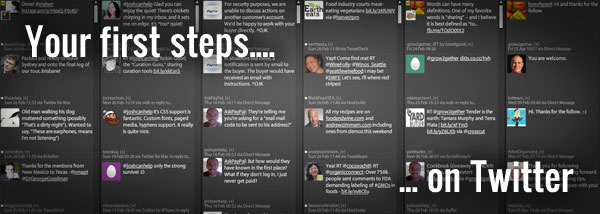This post is for anyone who just signed up for Twitter and thought, “OK, now what?” It’s for the businesses and individuals curious about how to get started on Twitter and have fun with it. This isn’t about ROI, it isn’t about analytics, and it isn’t about strategy. It’s about what I like to create and engage with and, simply, where to start if you’re taking the first step and you’re already lost.

As always, I’ll begin with a disclaimer: this isn’t a rulebook. This is just a way to simplify your thinking about what can be done with this active and fascinating social network. I’m of the mind that more people using these networks to communicate, rather than just promote what they’re doing, makes the experience stronger and much more enjoyable.
It’s a Conversation
Without getting too philosophical or esoteric, the easiest way to think about Twitter is as one big conversation, like you’d have in a crowded bar. It’s a bit distracting, you don’t really every have someone’s full attention, and there is a LOT going on.
The best way to make a party work is to be mindful of the environment you’re in and help everyone else have as good of a time as you want to have. You want to come with something interesting, make other people feel good, and make it easy to get to know you.
If you get the sense that this advice might be more broadly applicable than just Twitter, I’d say you’re right.
30 – 40 – 30 – The Triad
So you’re logged in, want to make a great impression, and ready to start. What do you tweet about? Concentrate on three things, equally distributed:
- Content, yours and others (30%)
- Retweets, replies, and conversation (40%)
- Your own words (30%)
The point in outlining these is not to lay down a framework that you should follow, it’s to help you think of what to do next when you’re sitting in front of that Tweetdeck window thinking “now what?”
There is, of course, lots of overlap between some of these activities but the motivation behind each is different and having a good spread between these three keeps you engaged and creating.
1) Content, yours and others [30%]
This consists of sharing the stuff you’re reading and creating online. This is fulfilled with those omnipresent Tweet buttons, applications like Instagram, and sharing your own posts and content.
The easiest thing to do is tweet what you read, watch, and write online. Add some micro-commentary (I just made that up… it means a few of your own words), add the author’s Twitter handle if you know it, and tweet it once. If it’s your own content, I think tweeting twice is OK but space it out over a day or so. It’s really easy to be overly self-promotional and that doesn’t fly on Twitter.
Anything you find online (that doesn’t require a login) can be tweeted but keep it relevant. I read all kinds of things online but I assume that my followers are there because I’m webby. I tweet all the web-related tips, tricks, and news I find and keep the homebrewing, cycling, and snowboarding stuff to a minimum (with a few exceptions, see #3 below).
A quick tech tip here, I’ve been using Buffer for a while and have really relied on it to make my limited time on Twitter work for me. It spaces tweets out throughout the day so if you read 5 things and want to tweet them all, they don’t all go out at once. Great app, works exactly as advertised.
2) Retweets, replies, and conversation [40%]
If you’re going to lean on something to help you get the most out of Twitter, lean on this one. If someone is on Twitter and their tweets are public, it’s an open invitation to say hi.
So, how does it work? I wouldn’t say there’s really any rules except the main one that applies everywhere: be respectful and kind. I find the easiest thing to do is to compliment someone on a post, throw in your two cents, or reply to a question. I have literally never gotten into a conflict on Twitter, I find it to be a generally very friendly place, at least the little niche that I stick in.
Replies are great but everyone loves retweets. I find lots of great content on Twitter that I read and engage with and try to retweet the person that found it “for me.” It’s a great way to introduce yourself to someone and a nice gesture.
As an aside, thanking people for retweets is not necessary. It’s fine to do and if it’s a cause or something you made, it makes more sense but it’s not a faux pas to abstain.
3) Your own words [30%]
This was the one I had the hardest time with. For the most part, I felt like I didn’t want to say anything online unless I had thought it out fully and had a rough draft. Could the world benefit from a little more fore-thought online? Most definitely but I’ve read some very funny and sometimes informative off-the-cuff tweets from people.
I tweet funny things I overhear (I spend a lot of time in coffee shops), odd and misguided things people say to me during meetings (always anonymously), and sudden realizations. There is certainly a line here and a fine filter is involved. But I just ask “would I say this to a colleague or a client and would they find it entertaining or interesting?” and if the answer is “probably” or “yes,” off it goes.
I also use Instagram and tweet out photos from my life. I’m usually taking artsy-fartsy pictures of my lattes at coffeeshops and other cliche Seattle things and who doesn’t like pretty pictures? Plus, I like people to get to know me a bit and the visual language of someone’s daily photos ends up being a pretty fascinating perspective, in my opinion.
Wrapping it up
Hopefully you got a few ideas for getting your words out there. I think keeping to this 30 / 40 / 30 plan for a while gets you comfortable with the idea of sharing your life and the tools you end up using. Getting started can be the hardest part and if you rope off because you didn’t know what to do, you might be missing out on some great interactions with people.
Give it a shot and if, after a month, you’re still “meh” about the whole thing, don’t feel bad if you never tweet again. Hey, at least you tried!
< Take Action >
Comment via:
Subscribe via:
< Read More >
Tags
Newer

Apr 03, 2012
My WordPress Developer's Wishlist
I build a lot of WordPress and I use WordPress all day, every day. Here’s what I’d love to see in future WordPress releases.
Older
Feb 24, 2012
Quora: Are CMSs are more awkward than helpful a lot of the time?
It took me a long time (4 years) to get to the point where almost every project I get is built in WordPress and I'll tell you the 3 keys to getting it right, for yourself and with clients.